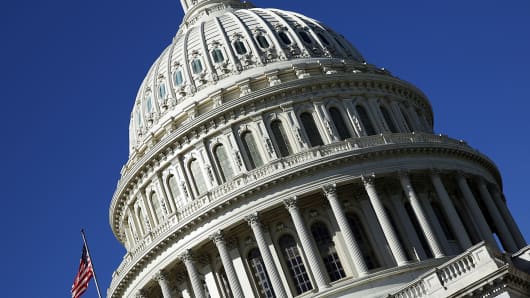We have an unfunded pension liability to federal employees of over $7 trillion and this grows almost $1 trillion per year. Couple this with the $70 trillion or so negative cash flow in the future for social programs and the failure of the United States is assured. As John Smith so concisely framed it, "There are two ways to enslave and conquer a nation: One is by the sword. The other is by debt."
(Read more: Companies with zero debt)
We gain no solace in the financial projections provided by the Congressional Budget Office and and Office of Management and Budget. They project GDP growth around 4 to 5 percent for 10 years, when we will be lucky to sustain 2 percent. They assume no recessions, no wars and no large terrorist acts or natural disasters. They assume interest rates will remain far below historical averages and worst of all, they assume no new spending by Congress. I project that our nation's debt will top 170 percent of GDP in 10 years, worse than Greece and second only to Japan.
The way the financial crisis will happen is the same way it happens everywhere else: Interest expense gets you. When markets fear risk, interest rates rise and lending stops. The creditor country must then balance its budget. By this time, interest expense becomes a very large proportion of the budget, crowding out pensions, medical and Social Security. Not all of these can be paid as promised: Something has to be cut.
(Read more: How to rescue your retirement at 55)
Interest expense will get the U.S. Today, we have ZIRP: Zero Interest Rate Policy that is masking our underlying problem. This has been brought on by Federal Reserve policy and economic problems in Europe that chased investors over here. These things will change. We will return to higher interest rates (an average of 6 percent over the last 40 years) hopefully from economic activity but likely from investors' risk assessment. In either case, interest rates can easily consume 25 percent of our federal tax receipts. We will be forced to balance our budget by the markets if we don't do it ourselves and we will be caught in the debt trap… in the fine company of Iceland, Ireland, Spain, Portugal, Greece and Italy.
But what does all this mean to you and me, and why so much concern in the financial community? The crisis that too much government debt creates is an economic and currency crisis. It is very similar to what happens when a person or business borrows too much debt: it enters the debt trap. As we have seen around the world recently, governments borrow themselves into the debt trap without a second thought, despite warnings from their own bankers, other countries and other central bankers.
Even more astounding is that the markets continue lending far beyond reason. This leads to recessions or depressions. We see unemployment of over 26 percent in Spain and worse in Greece. Interest expense alone will cost this next generation $720 billion per year, $7.2 trillion per decade and $36 trillion over a typical 50-year career. And this is assuming no additional debt that entire time. This is now the next generation's burden … and for what great cause was all this money borrowed?
(Read more: The most widely-held stock in 401(k) plans)
Economic growth is the only way out, but this is the tough part. The government needs more revenue and needs economic growth to get it. They then call on the central bank to start printing money ("quantitative easing") to stimulate economic growth. If the central bank prints too much money, hyper-inflation will crush the currency, creating a currency crisis and recession or depression.
The answer for most countries is to make "structural changes," or spending cuts. This is the only way out because new taxes hurt GDP growth. Just imagine cutting 25 percent of Medicare, Medicaid, Social Security and Obamacare. Where would this lead?
The United States is in the debt trap but we have yet to feel its teeth because of a confluence of beneficial anomalies have kept our interest rates at near zero. The days of zero interest rates will end and the trap will close around the country and every citizen.
Can Congress or the Fed sprinkle pixie dust on it and make it all go away? Unfortunately, the laws of economics are like the laws of physics: They cannot be manipulated by Congress or the Fed … there is no easy way out.
The only "American" way out is how we got out of the World War II debt: Balance the budget and grow GDP at 2 to 3 percent for 30 years and we can get back to the debt-to-GDP ratio we had in 2008. This country needs courageous active citizens to become leaders in their own world by educating everyone they know — at school, at work and socially — as to the events that are going to unfold here on our own soil.
(Read more: Obama's worst week so far — why it matters)
— By Murray T. Holland
Murray T. Holland is a 30-year veteran of the finance industry and managing director of Dallas-based MHT Partners. He is the author of "A Nation in the Red" (McGraw Hill, 2013).


